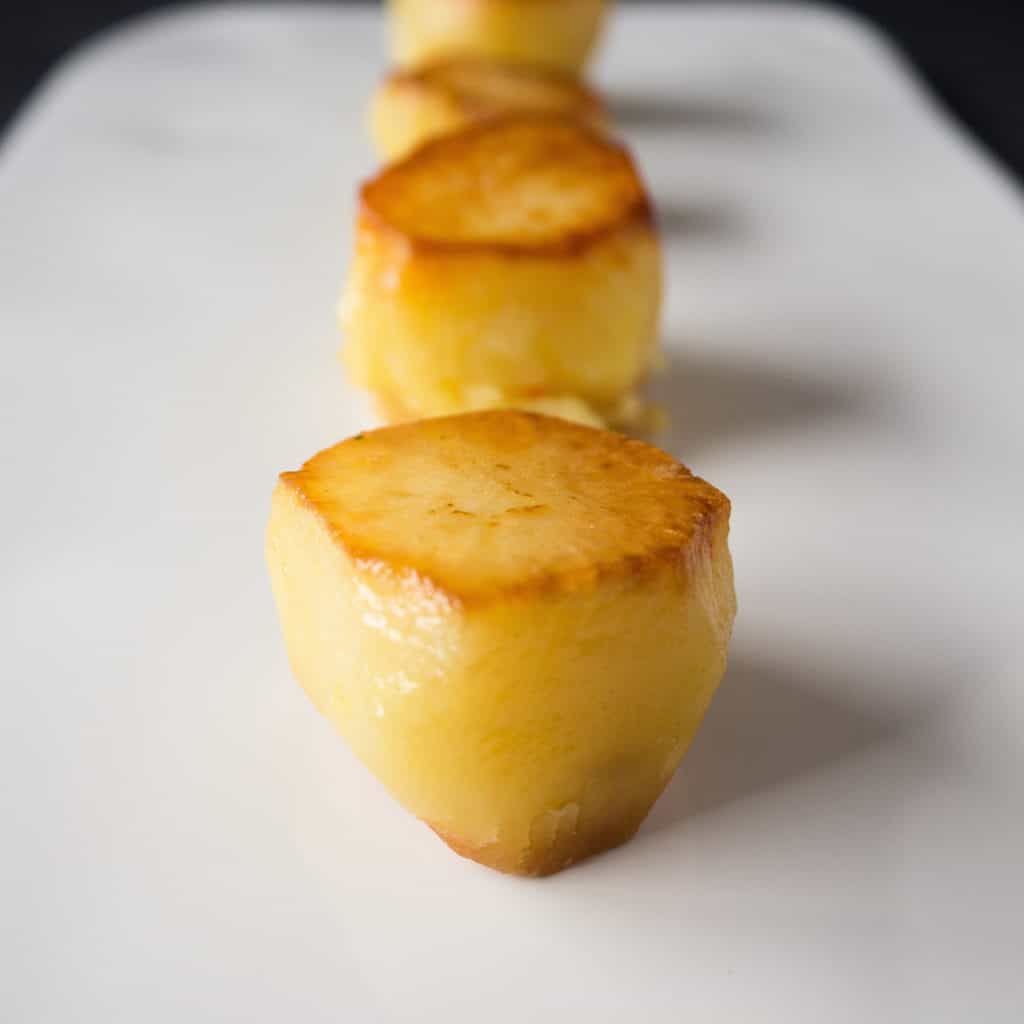
These Rich and Decadent Gluten-Free, Vegan Fondant Potatoes are magical. Fondant potatoes are traditionally cooked in butter and stock. How hard can this be to veganise? Not hard at all. These have a wonderful slightly salty, deep flavour and they melt in your mouth. They are rich and delicious. With the weather starting to change and become more autumnal… (bearing in mind it might change agian next week!) they are perfect as a side.
Gluten free, Vegan Fondant Potatoes are easy to make and takes less than 30 minutes to make.
Gluten free, Vegan Fondant Potatoes are gluten-free, vegan as well as… celery free, coconut free, garlic free, lupin free, mustard free, nightshade free, onion free, peanut free, sesame free, soya free, tree nut free.
You can make these any shape or size you like as long as they have a flat top and bottom. Traditionally they are cut using pastry rings to make them round and then the edges are shaped. I turned mine and made mini ones with some quite small potatoes. Bigger potatoes will take longer to cook.
You can find the full Gluten-Free, Vegan Fondant Potato recipe here.
Gluten free, Vegan Fondant Potatoes are rich and unctuous and are a great side when you want to spoil yourself. They will go really well with Gluten Free Vegan Haggisfor a special weekend meal or would work incredibly well as a side to a salad such as Warm Pear Salad.
Gluten free, Vegan Fondant Potatoes are easier and quicker to make than you think. Long, slow cooking will give you rich, delicate and unctuous potatoes.
Top top! Be careful when removing the potatoes from the pan. They do become rather fragile.
Preparation
Difficulty easy
Preparation time 10 minutes
Cooking time 20 minutes
You can find the full Gluten-Free, Vegan Fondant Potato recipe here.
Allergens
These Fondant Potatoes are gluten-free and vegan as well as…
Celery free
Coconut free
Garlic free
Lupin free
Mustard free
Nightshade free
Onion free
Peanut free
Sesame free
Soya free
Tree nut free
About
Potatoes are the foundation of much British and European cookery and a staple crop. But, as with many ‘traditionally British’ ingredients, potatoes are not native to the UK, or to Europe for that matter. We all remember the stories of the potato being introduced by Sir Walter Raleigh of Sir Francis Drake back in the seventeenth century but the reality is that potatoes have been known in Europe since the sixteenth century. They were originally eyed with suspicion and thought to be poisonous. Potatoes were used as animal feed before catching on as a nutritious vegetable and important food staple and crop. It is thought that the potato played a significant role in the nineteenth century European population boom.
We do know that the potato originated in South America and is believed to have been domesticated in modern-day southern Peru and north west Bolivia between 8000 and 5000 BC. The Spanish introduced the potato to Europe in the second half of the 16th century; following the Spanish conquest of the Inca Empire. Potatoes were then conveyed by European mariners to territories and ports throughout the world.
There was a lack of genetic diversity in potato crops in Europe, due to the very limited number of varieties initially introduced, this left the crop vulnerable to disease. In 1845, a plant disease known as late blight, spread rapidly through the poorer communities of western Ireland as well as parts of the Scottish Highlands, resulting in the crop failures that led to the Great Irish Famine.
Thousands of varieties of potato still exist in the Andes. It is estimated that over 100 cultivars might be found in a single valley. One agricultural household could maintain over 10 varieties.
Raw potato consists of 79% water, 17% carbohydrates (88% of which is starch), 2% protein and negligible fat. In a 100 gram amount, raw potato provides 77 calories and is a rich source of vitamin B6 and vitamin C (23% and 24% of the Daily Value, respectively), with no other nutrients in significant amount (table). When a potato is baked, vitamin B6 and vitamin C reduce with little significant change in other nutrients.